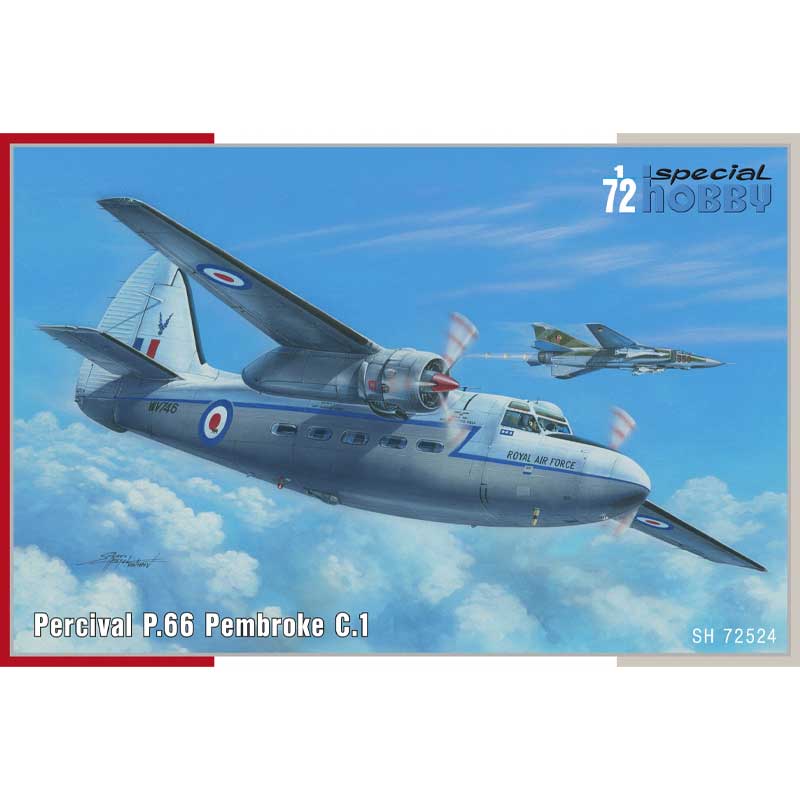The Special Hobby SH72524 1/72 Percival P.66 Pembroke C.1 is a 1/72 scale model kit of the Percival P.66 Pembroke C.1, a British military transport aircraft that was developed and used primarily during the Cold War. This kit represents a military version of the P.66 Pembroke, specifically the C.1 variant, which was used by the Royal Air Force (RAF) for transport and reconnaissance missions.
Key Features of the Kit:
- Scale: 1/72
- Manufacturer: Special Hobby, known for producing well-detailed kits of often underrepresented or niche aircraft.
- Aircraft: The Percival P.66 Pembroke was designed as a military transport aircraft with a high-wing monoplane configuration. It had a distinctive appearance with a twin-engine setup and tailwheel landing gear. The C.1 variant was a military version, equipped for transport duties, often used by the Royal Air Force and other military operators.
- Markings: This version represents the C.1 model, which would have served in the Royal Air Force or potentially other military services using the aircraft for cargo and personnel transport. The decals included in the kit would likely represent RAF squadrons or possibly Royal Navy or Royal Australian Air Force (RAAF) markings.
- Quality: Special Hobby kits are generally well-regarded for their attention to detail, especially for less mainstream aircraft like the Percival Pembroke. Expect highly detailed plastic parts, with possible resin components for specific areas like the engine, landing gear, or cockpit details. The kit might also include photo-etched parts for added realism, particularly for cockpit details and fine structural components.
Key Details About the Percival P.66 Pembroke C.1:
- Role: The P.66 Pembroke was primarily used as a military transport aircraft. It was capable of carrying small groups of personnel, light cargo, and was occasionally used for reconnaissance or surveillance missions. Its STOL (Short Takeoff and Landing) capabilities made it well-suited for operations from smaller airfields, making it a versatile asset in various military scenarios.
- Design: The P.66 featured a high-mounted wing, twin engines, and a tailwheel landing gear, which were typical features for a military transport aircraft of the era. The design was robust, capable of handling rough airstrips, and its engines were mounted on the wing’s leading edge for better efficiency and performance.
- Performance: Powered by Alvis Leonides radial engines, the P.66 had a top speed of around 220 mph (355 km/h) and a service ceiling of 20,000 feet (6,100 meters). The aircraft was capable of carrying up to 10 fully equipped troops or 1,500 kg (3,300 lbs) of cargo, making it suitable for a wide range of transport roles.
- Operators: The Royal Air Force (RAF) was the primary operator of the P.66 Pembroke, using it for light transport, reconnaissance, and occasionally for maritime patrols. The Royal Navy and Royal Australian Air Force (RAAF) also operated variants of the Pembroke. Some were used for VIP transport and could be fitted with equipment for surveillance or communication tasks as well.
Historical Context and Significance:
The Percival P.66 Pembroke C.1 played an important role in the Royal Air Force’s transport operations during the Cold War era, often operating in more austere environments or areas where larger aircraft couldn’t operate. Its STOL capabilities made it ideal for operations in remote or unimproved airstrips, which was crucial for military and humanitarian operations during the post-WWII period.
The P.66 was a sturdy and reliable workhorse, able to handle both transport and reconnaissance duties, making it a versatile part of many air forces’ fleets. Although it was eventually replaced by more modern aircraft like the Twin Pioneer and Shorts Skyvan, the Pembroke was an important piece of military aviation history.


